I remember the days when I learned how to scuba dive. I was so hooked on it that I wanted to hone my diving skills to feel confident and meet like-minded people worldwide. This is why I’m revealing the best liveaboard diving destinations for new divers.
Where are the best liveaboard diving destinations for new divers?
Belize, Thailand, Cayman Islands, Bahamas, Turks and Caicos Islands, Maldives, the Red Sea – Egypt, Honduras, and the British Virgin Islands are excellent destinations to start your first liveaboard diving experience. These locations offer remote dive sites that add a sense of adventure, opportunities to share stories with fellow divers, warm and clear waters, and excellent visibility. Additional dive courses are offered to enhance your dive skills.
1. Belize
Belize, nestled in the heart of the Caribbean along Central America’s northeastern coast, is a wall diver’s utopia.
One of Belize’s standout features is its position along the valuable Mesoamerican Barrier Reef, the world’s second-largest barrier reef. This vibrant underwater ecosystem offers a sense of adventure and exploration. New divers can enjoy diving from liveaboards to experience hovering over popular vertical wall drop-offs and accessible dive spots like the magnificent coral Lighthouse Reef, Half Moon Caye, and Turneffe Reef.
These dive sites are easily reachable by liveaboard from Belize City, and are ideal for you, except for the famous Blue Hole, which is more suited for those with advanced experience.
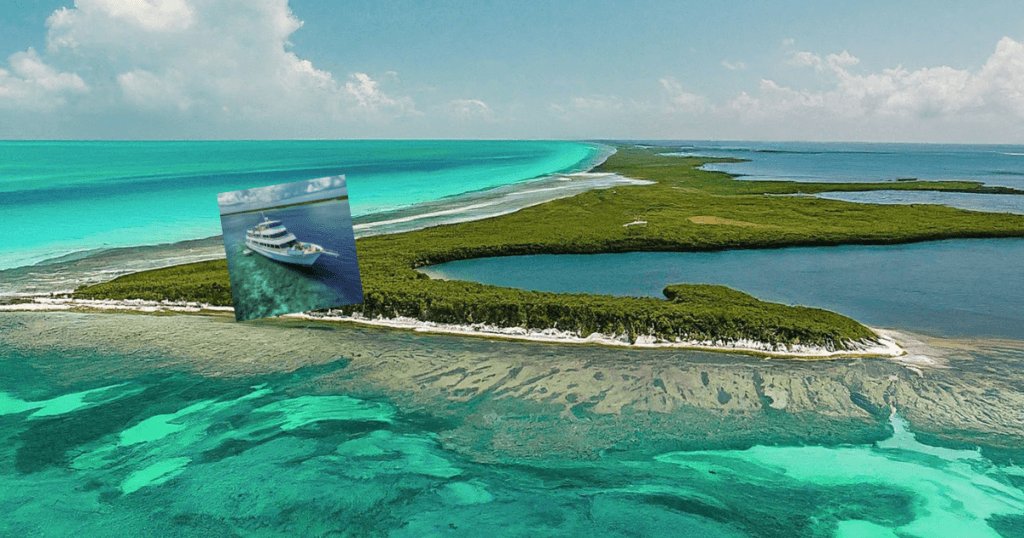
Belize Liveaboard For New Divers Overview
Recommended Liveaboard for New Divers: Belize Aggressor IV
Ideal Itinerary: Belize Exploration – Lighthouse Reef, Half Moon Caye, and Turneffe Reef
Port of Departure: Radisson Ft. George, Belize City
Sample Dive Sites and More:
- Dive Sites: Painted Wall, Lighthouse Reef, Half Moon Caye Wall, Quebrada and the (Blue Hole – recommend a minimum of 20 logged dives)
- Includes: Day trips to Mayan ruins and other activities
Scuba Course(s): PADI Open Water Dive Course ($) to improve your dive skills and dive deeper.
Number of Dives: Approximately 22 on a popular 7-night trip
Dive Experience Required: Open Water certification with no minimum logged dives
Sea Creatures Highlight: Turtles, dolphins, eagle rays, reef sharks, moray eels, spiny lobsters, crabs, crimson Gorgonians, walls, reefs, and possibly whale sharks
Best Diving Time:
Optimal Seasons
- August – October: 28-29°C (82- 84°F) Warmest but it’s hurricane season.
- October – November: Grouper mating season.
- November – July – Weather and water temperature are slightly cooler but you’ll be comfortable wearing a shorty. November to March, when visibility is exceptional and waters are calm. *April to June (whale shark season).
More Reasons Why Belize is Great for New Divers:
- Mild Currents: Gentle currents and drift dives help you improve your diving skills.
- Shallow Dives: Starting at around 8 meters (25 feet) makes it more manageable for beginners.
- Outstanding Visibility: Often exceeds 30 meters (100 feet).
- Comfortable Water Temperature: Around 25 to 28°C (78 to 82°F).
2. Thailand
Scuba diving along Thailand’s coastline is a favourite activity for many, however, the best spots for liveaboard diving for new divers are found in the more remote areas of the Andaman Sea. Here, you can explore the underwater marvels of the Similan Islands, renowned worldwide for their vibrant hard and lush soft coral reefs.
Diving at locations like Koh Bon and Koh Tachai gives opportunities to encounter graceful manta rays and, if you’re lucky, enormous whale sharks.
One of the standout dive sites is the famous Richelieu Rock, where new divers like you, can experience a bit of current, offering a gentle challenge to improve your diving skills. Many liveaboards offer the PADI Advanced Open Water Course to venture deeper than the standard 18 meters (60 feet). These dive spots are ideal for you, thanks to their calm waters and abundant marine life.
Travel during the right season, and you’ll enjoy superb diving conditions, with mostly shallow dives that make navigation easy and fun.
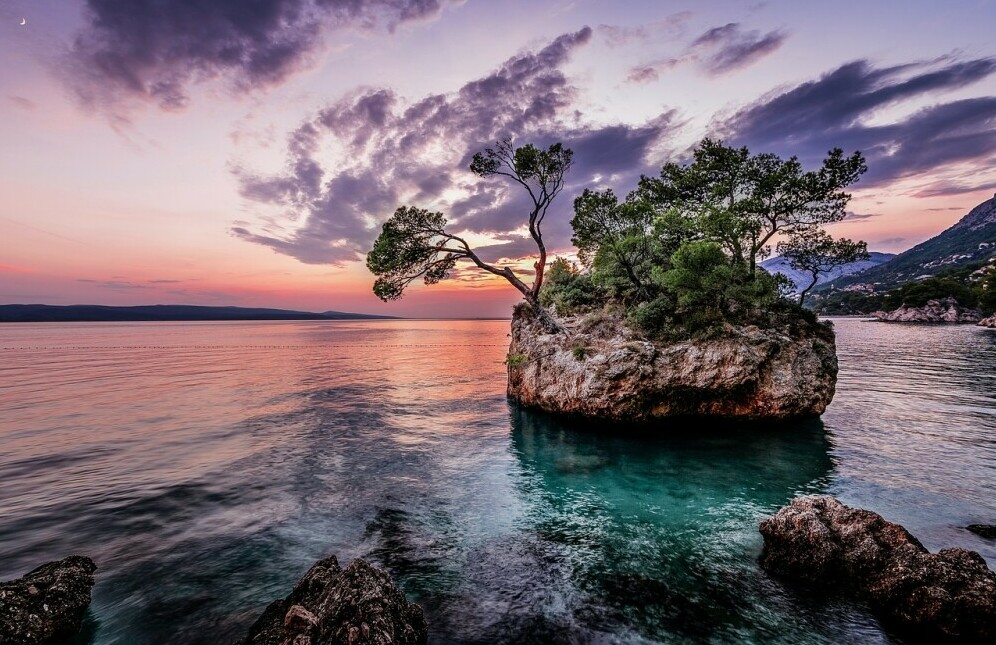
Thailand Liveaboard For New Divers Overview
Recommended Liveaboard for New Divers: Sawasdee Fasai
Ideal Itinerary Similan – Koh Bon – Koh Tachai – Richelieu Rock (Tablamu Pier – Tablamu Pier)
Port of Departure: Tablamu Pier, Phang-Nga Province (near Phuket and Khao Lak)
Sample Dive Sites: Similan Island, Koh Tachai, Richelieu Rock, and Koh Bon.
Scuba Course(s): Deep Adventure Dive or PADI Open Water Dive Course ($) to improve your dive skills and dive deeper.
Number of Dives: Approximately 14 dives (4 nights)
Dive Experience Required: Open Water – 5 minimum logged dives required. There will be some dives greater than 18 meters (60 feet).
Sea Creatures Highlight: Vibrant coral reefs, reef fish, turtles, graceful manta rays, and with luck, massive whale sharks.
Best Diving Time:
Optimal Season: October to May
More Reasons Why Thailand is Great for New Divers:
- Mild Currents: Normally mild currents help you improve your diving skills
- Dive a little deeper: Get more education to build up your confidence and see manta rays and hopefully whale sharks
- Outstanding Visibility: 20 – 40 meters (65 – 130 feet)
- Comfortable Water Temperature: Year-round, from 26 – 30° C (79-86°F)
- *July to October (Rainy Season)
3. The Cayman Islands
Snuggled in the western Caribbean Sea, the Cayman Islands are a diver’s Garden of Eden, featuring dramatic wall drop-offs plunging to depths of 1800 meters (6000 feet). This British Overseas Territory is composed of three islands: Grand Cayman, Little Cayman, and Cayman Brac, each offering its own unique charm and incredible diving adventures.
With crystal-clear waters and visibility often exceeding 100 feet, the Cayman Islands are perfect for you to embark on your first liveaboard adventure. You’ll love it!
The liveaboard options here cater to various skill levels and offer dive sites that will leave everyone in awe. Imagine diving at Bloody Bay Wall on Little Cayman, exploring the fascinating USS Kittiwake Wreck on Grand Cayman, or interacting with the friendly stingrays at Stingray City. The reefs are vibrant and bustling with life, featuring colourful corals, tropical fish, sea turtles, sharks, crabs, and lobsters that hide in crevices.
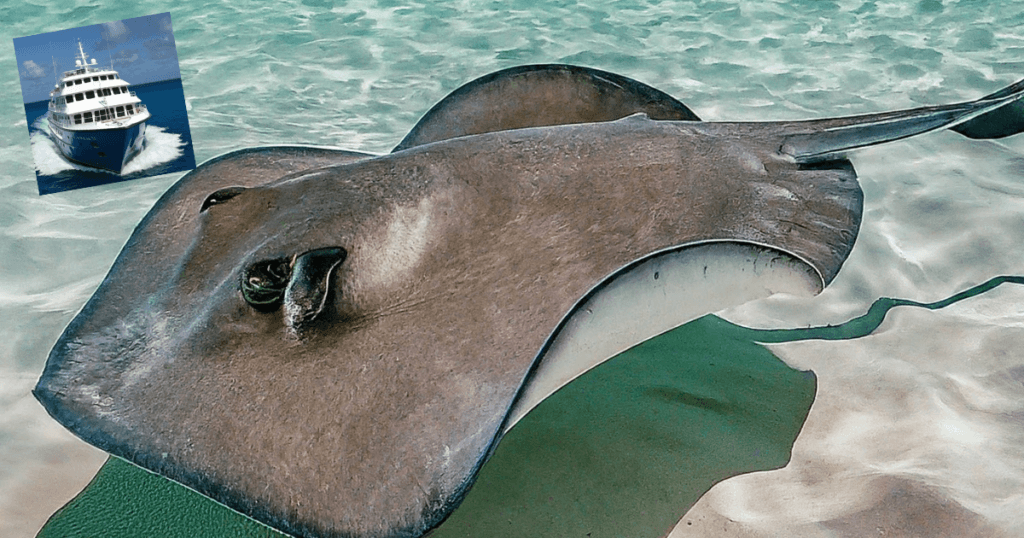
Cayman Islands Liveaboard For New Divers Overview
Recommended Liveaboard for New Divers: MV Cayman Aggressor IV
Ideal Itinerary: Best of the Cayman Islands (Georgetown – Georgetown)
Port of Departure: Georgetown
Sample Dive Sites and More: Grand Cayman, Little Cayman, and Cayman Brac feature amazing spots like the infamous Russian Destroyer, and the Doc Polson, Bloody Bay Wall, Stingray City, Northwall, Southwall, the World War II, USS Kittiwake ship artificial reef.
Scuba Course(s): PADI Open Water Dive Course to improve your dive skills and dive deeper ($)
Number of Dives: Approximately 22 dives (7 nights)
Dive Experience Required: Open Water – No minimum logged dives required.
Sea Creatures Highlight: Encounter vibrant corals, colourful tropical fish, spotted eagle rays, reef sharks, nurse sharks, green sea turtles, eels, groupers, stingrays
Best Diving Time:
- Optimal Seasons: December to May (Dry season)
- ** Hurricane season is from June to November
More Reasons Why the Cayman Islands is Great for New Divers:
- Mild Currents: Mild to moderate, perfect to help you manage your buoyancy.
- Shallow Dives: Relatively shallow, with many starting around 8 meters (25 feet). You can stay down longer.
- Outstanding Visibility: Ranging from 18 – 30 meters (60 – 100 feet)
- Comfortable Water Temperature: Year-round, ranging from 26-28°C (78-82°F).
4. The Bahamas
Imagine an archipelago of almost 700 coral islands with its identity as a large underwater cave system in the West Atlantic Ocean. This is the Bahamas, not only is it conveniently close to Florida, USA, but it’s also a fantastic destination for new divers looking to experience their first thrill of liveaboard diving.
The renowned Andros Barrier Reef in the Bahamas is the third longest barrier reef in the world stretching to 200 km (124 miles) with 164 delightful fish species.
You’ll enjoy an excellent variety of dive sites suitable for beginners from shallow reefs, historical wrecks, tunnels, and unique attractions like the blue holes of Andros Island. There are minimal currents, and possibly some rough surface waters but you can easily remove your gear, hand it to the crew and make your way up the ladder of your liveaboard.
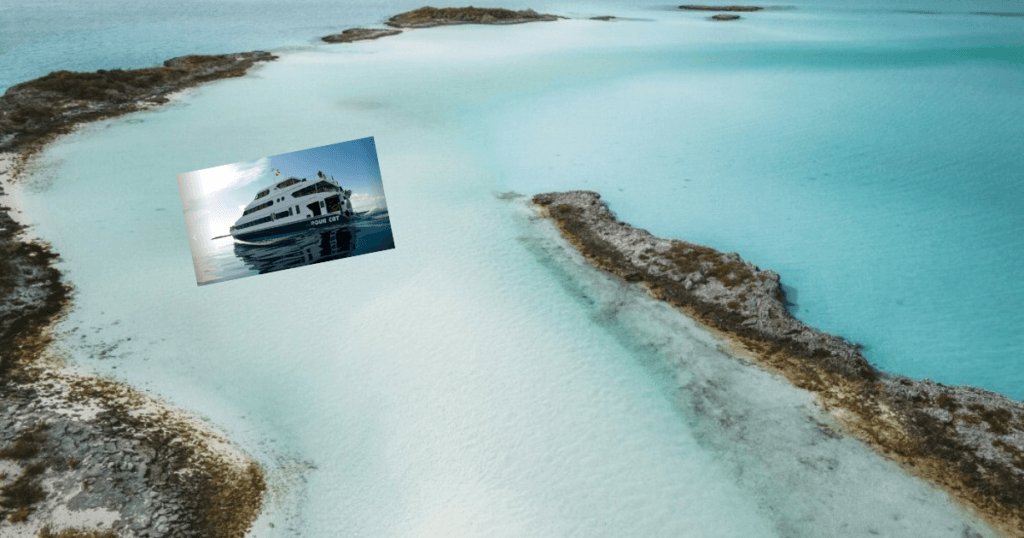
Bahamas Liveaboard For New Divers Overview
Recommended Liveaboard for New Divers: Aqua Cat
Ideal Itinerary: The Best of the Bahamas (Nassau – Nassau)
Port of Departure: Hurricane Hole Marina, Nassau
Sample Dive Sites: Austin Smith Wreck, Jeep Reef, Lost Blue Hole, Amberjack Reef, Exumas Land and Sea Park, Washing Machine (not for new divers)
Scuba Course(s): PADI Open Water Dive Course to improve your dive skills and dive deeper.
#No. Of Dives: Approximately 26 dives (7 nights)
Dive Experience: Open Water, No minimum logged dives required
Featured Sea Creatures: Colorful coral reefs, sea turtles, shy nurse sharks, stingrays, tiger and Caribbean reef sharks, and hammerheads.
Best Diving Time:
Optimal Season: October – June (more sharks and no diver crowds)
More Reasons Why The Bahamas is Great for New Divers:
- Mild Currents: Perfect for new divers to gain confidence
- Shallow Dives: Some good wrecks
- Outstanding Visibility: Usually 24 – 30 meters (80 – 100 feet)
- Comfortable Water Temperature: Year-round 24-30°C (75-86° F) between seasons
5. Turks and Caicos Islands
Having lived in the Turks and Caicos Islands for 4 ½ years, I can say it’s one of my most treasured utopia islands for scuba diving. The islands are part of the British Overseas Territories. I finished my PADI Open Water Diver Course there many years ago.
It’s only 925 kilometres (575 miles) southeast of Miami, Florida, USA. You can easily fly to the Providenciales International Airport and dive in the calm, clear, and turquoise waters from a liveaboard ideal for a new diver.
When diving from a liveaboard in the remote sites of the Turks and Caicos Islands, you can expect breathtaking underwater visibility, usually between 24 – 30 meters (80 – 100 feet). This clarity allows for stunning views of the vibrant coral reefs and diverse marine life. Your dives will take you through swim-throughs and dramatic drop-offs, where you can gracefully hover over the walls and peek into tiny crevices to discover hidden nocturnal creatures.
The currents at the dive sites are generally mild, making it perfect for new divers.

Turks and Caicos Islands Liveaboard For New Divers Overview
Recommended Liveaboard for New Divers: Turks and Caicos Aggressor II
Ideal Itinerary: Providenciales, West Caicos and French Cay (Providenciales – Providenciales)
Port of Departure: Providenciales
Sample Dive Sites: West Caicos, French Cay, Northwest Point
Scuba Course(s): PADI Open Water Dive Course to improve your dive skills and dive deeper($)
#No. Of Dives: Approximately 22 dives (7 nights)
Dive Experience: Open Water – No minimum logged dives required
Featured Sea Creatures: Turtles, gray reef sharks, dolphins, frogfish, spotted eagles rays, groupers, sometimes hammerheads and blacktip sharks, large schools of horse-eye jacks, magnificent sponges and sea fans, maybe humpback whales.
Best Diving Time:
Optimal Season:
- Year-round
- Most popular: November – May
- January – March – Humpback whales
Hurricane season is June-November so expect rain and wind (check the weather).
More Reasons Why Turks and Caicos Islands is Great for New Divers:
- Water Temperature: From 25°C (77°F) in the winter months to around 29°C (84°F) in the summer months.
- Excellent Visibility: From 20 to 40 meters (65 to 130 feet).
- Diving Depths: From 12 – 30 meters (40 – 100 feet).
6. Maldives
The Maldives, positioned in the north-central Indian Ocean, is a tropical dream come true for many divers’ travel bucket lists. Known for its 26 beautiful atolls and pristine white sandy beaches, the Maldives offers an unforgettable experience with memories of clear turquoise waters.
For diving enthusiasts, the Maldives is an underwater haven. Whether diving or snorkelling from a liveaboard, as a new diver, you’ll find some of the world’s best marine adventures in their remote sites. Imagine exploring the waters at Maaya Thila and Rasdhoo Atoll, where you can encounter graceful manta rays, massive-bodied whale sharks, vibrant reef fish, and curious green turtles.
The Maldives’ dive sites are renowned for their abundant marine life and breathtaking underwater landscapes like the vivid coral gardens and intricate reef structures. The currents are generally mild, making it an ideal location to gain experience and confidence diving from a liveaboard.

Maldives Liveaboard For New Divers Overview
Recommended Liveaboard for New Divers: Scubaspa Yang (multiple awards)
Ideal Itinerary: Best of Maldives (Male – Male)
Port of Departure: Male
Sample Dive Sites: North Male Atoll, South Male Atoll, Ari Atoll, Rasdhoo & Vaavu Atoll
Scuba Course(s): PADI Open Water Dive Course ($) to improve your dive skills and dive deeper.
Special Amenities and Activities: Jacuzzi, onboard gym, and spa, yoga, PADI Advanced Open Water Dive Course ($) to improve your skills and give more confidence.
#No. Of Dives: Approximately 15 dives (7 nights)
Dive Experience: Open Water – No minimum logged dives required
Featured Sea Creatures: Gentle whale sharks, giant manta, dolphins, green turtles, reef sharks, eagle rays, batfish, scorpionfish, large trevally and snapper schools, Napoleon wrasse, underwater pinnacle with stunning corals
Best Diving Time:
Optimal Season
- December – May: Northeast Monsoon is good diving with mostly clear skies for your dives at the eastern atolls and clear visibility.
More Reasons Why The Maldives is Great for New Divers:
- Non-divers are welcome!
- Amazing Visibility: From 20 to 40 meters (65 to 130 feet).
- Warm Water Temperature: Generally between 27°C to 30°C (80°F to 86°F).
- Varied Dive Depths: From shallow sites for new divers around 12-18 Meters (40 – 60 feet). Deeper dives up to 30 meters (100 feet) for more experienced divers.
7. Egypt – The Red Sea
The Red Sea curiously draws in divers looking for cool historical wreck diving adventures and clear waters. It’s perfect if you’re a new diver looking to improve your dive skills with fun swim-throughs, tunnel diving, easy drift diving and mild currents. Your reward will be an underwater amphitheatre of rich sea life from cute dolphins, batfish, large schools of fish, the haunting wrecks, and abundant, and healthy coral reefs.
Close your eyes and imagine yourself diving with a swirling, dancing school of black-tailed trevally fish! What a sight to see!
The only way to do this is with a liveaboard taking you to these remote locations. You can snorkel too, so bring your partner with you.
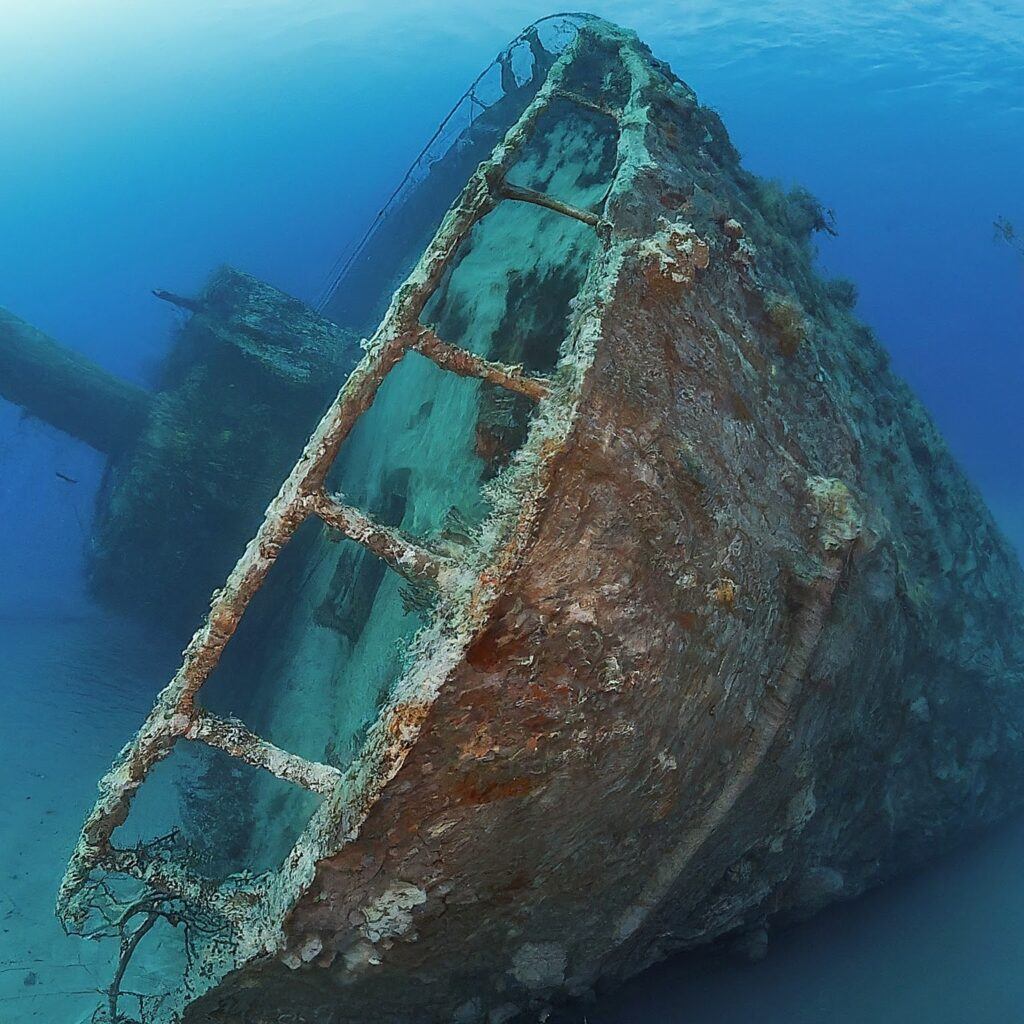
Egypt – The Red Sea Liveaboard For New Divers Overview
Recommended Liveaboard for New Divers: Red Sea Aggressor II
Ideal Itinerary: Northern Red Sea, Ras Mohamed, Straits of Tiran (Hurghada – Hurghada)
Port of Departure: Hurghada
Sample Dive Sites: Poseidon Reef, Abu Nuhas (Wreck), Gubal Island, Beacon Rock, Sha’ab Mahmoud (Wreck), Tiran Island, Ras Mohamed, SS Thistlegorm, Kingston (wreck), Sha’ab El Erg, Umm Gammar, Giften Island
Scuba Course(s): PADI Open Water Dive Course($) to improve your dive skills and dive deeper.
#No. Of Dives: Approximately 20 dives (7 nights)
Dive Experience: Open Water – No minimum logged dives required.
Featured Sea Creatures: Large schools of jacks, trevallies, barracudas, Scorpionfish, stonefish, Anemonefish, sweetlips, goatfish, Napoleon wrasse, batfish, dolphins, turtles, colourful reef fish, amazing colourful hard and soft corals
Best Diving Time:
Optimal Season: March to May and September to November
More Reasons Why Egypt – The Red Sea is Great for New Divers:
- Water Temperature for March-May: 22°C (72°F) in March to 26°C (79°F) by May.
- Water Temperature for September – October: From 28°C (82°F) in September and cools down to 24°C (75°F) by November.
- Visibility: Excellent, from 20 to 40 meters (65 to 130 feet).
- Depth of Dives: Around 5 – 30 meters (16 – 100 feet). As a new Open Water Diver, your deepest dive is 60 ft. so your tour guide/Instructor will take you to places no deeper than that.
8. Honduras
Honduras is conveniently positioned in Central America. Surrounded by Guatemala, El Salvador, and Nicaragua, this country boasts one of the most eye-catching coastlines extending along the Caribbean Sea to the north and the Pacific Ocean to the south.
Divers flock to Honduras for its renowned Bay Islands—Roatán, Utila, and Guanaja. These islands form part of the Mesoamerican Barrier Reef, the second-largest barrier reef globally. They are celebrated for their diverse marine life and exceptionally, clear waters.
Exploring the underwater wonders of Honduras, such as encountering magnificent whale sharks, wall diving, volcanic formations, and the historic Odyssey Wreck, is best enjoyed through the liveaboard expeditions. These trips cater to new, novice and experienced divers, offering tranquil seas, excellent visibility, and warm temperatures ideal for you.
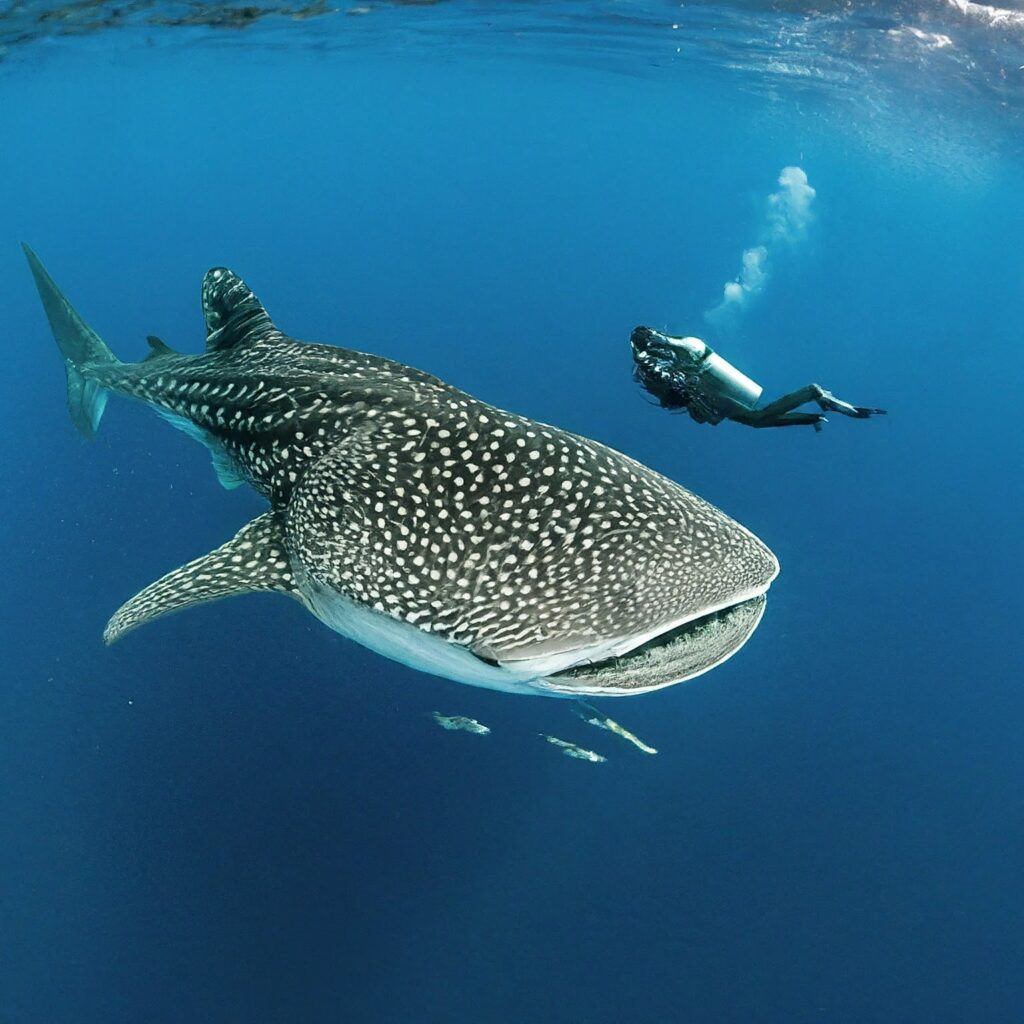
Honduras Liveaboard For New Divers Overview
Recommended Liveaboard for Beginners: Roatan Aggressor, Honduras
Ideal Itinerary: Roatan, Utila & Cayo Cochinos (French Harbor – French Harbor)
Port of Departure: Roatan Yacht Club & Marina
Sample Dive Sites: West end of Roatan, possible south side of Roatan, Seamounts & Cayos Cochinos, Utila
Scuba Course(s): PADI Open Water Dive Course($) to improve your dive skills and dive deeper.
#No. Of Dives: Approximately 22 dives (7 nights)
Dive Experience: Open Water – No minimum logged dives required
Featured Sea Creatures: Stunning remote underwater mountains rising from the seafloor, graceful manta rays, massive whale sharks, moray eels, fascinating wrecks, colourful coral reefs, schools of Southern Sennets, turtles, dolphins, eagle rays
Best Diving Time:
- Optimal Season: March – June (stable weather and calm water with a possible opportunity to see whale sharks)
More Reasons Why Egypt – The Red Sea is Great for New Divers:
- Water Temperature: Ranges from 27°C to 29°C (81°F to 84°F).
- Visibility: Excellent, ranging from 20 to 30 meters (65 to 100 feet).
- Marine Life: Active marine life, including opportunities to see whale sharks, especially around Utila.
9. The British Virgin Islands
Located east of Puerto Rico and in the eastern part of the Caribbean Sea, this British overseas territory, the British Virgin Islands is a place of remote tranquillity and adventure of the remnants of their volcanic past.. It’s made up of 4 main islands, Jost Van Dyke, the larger island Tortola, Virgin Gorda (“Fat Virgin” lying on her side from a distance), and the Anegada and 50 smaller islands.
The physical features of these islands present a showcase of hilly surroundings with lagoons caressed by outstanding coral reefs and interesting barrier beaches. Each of the main islands’ shapes has its aura of mystery from flatness, long and narrow, hilly to rugged.
Many new divers like you, come here for their first experience of diving from liveaboards. There are over 100 dive sites, so the only possible way you can dive them is with an extended stay. The islands are acclaimed with fascinating famous wrecks like the RMS Rhone and the Chikuzen.
For sure, you will want to venture back and complete your dive log book!

British Virgin Islands Liveaboard For New Divers Overview
Recommended Liveaboard for Beginners: All Star Cuan Law, British Virgin Islands
Ideal Itinerary: Dive the British Virgin Islands (Roadtown, Tortola – Roadtown, Tortola)
Port of Departure: Roadtown, Tortola
Sample Dive Sites: Cooper Island, Salt Island (Wreck of the Rhone), Ginger Island, Virgin Gorda Island, out into the Atlantic Ocean (Wreck of the Chikuzen), Atlantic Site, The Dog Islands
Scuba Course(s): PADI Open Water Dive Course($) to improve your dive skills and dive deeper.
#No. Of Dives: Approximately 18 dives (6 nights)
Dive Experience: Open Water – No minimum logged dives required
Featured Sea Creatures: Sea turtles, stingrays, spotted eagle rays, reef sharks, nurse sharks, green moray eels, shrimps, barracuda, crabs, lobsters, interesting swim-throughs, anemones, and a variety of colourful reef fish.
Best Diving Time:
Optimal Season:
- December to April for the best weather and diving conditions.
- May – November is less crowded and you can find cheap deals. (Remember June – November is hurricane season)
More Reasons Why British Virgin Islands is Great for New Divers:
- Water Temperature: Year-round, ranges from 25°C winter –29°C summer (78° – 84°F)
- Visibility: Excellent, from 18 – 30 meters (60 – 100 feet)
- Depth of Dives: Beginner divers will enjoy their dives within 10 – 18 meters (30- 60 ft.)
Final Verdict
Scuba diving from a liveaboard, especially when you’re a new diver, is an unforgettable experience. You can explore many remote diving destinations that day boats can’t reach. By taking the step to challenge yourself, you’ll quickly fill up your dive log book by doing multiple dives daily, boosting your confidence and opening up opportunities to take additional PADI courses.
What destination did you choose? Let me know in the comment box below, and I will get back to you.

